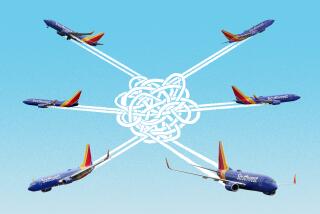Airlines Focus on Conserving Fuel
- Share via
U.S. airlines are reducing flight speeds, shortening routes and modifying planes to squeeze savings from fuel budgets that have climbed $3 billion and may lead to a fourth year of losses.
AMR Corp.’s American Airlines, the world’s largest air carrier, will cut almost $11 million by reducing reserve fuel on transatlantic flights, the company said. UAL Corp.’s United, the No. 2 airline, cut speeds over the Memorial Day weekend about 3% at its Ted unit to test the effect on fuel use. Southwest Airlines Inc., the most successful low-cost airline, said it would save as much as $10 million by installing curved wingtips on its Boeing 737-700 jetliners.
“Rarely have we looked so hard at the weight on the airplanes, at the routings we’re using, at our fear of congested airspace and congested runways and taxiways,” said John Heimlich, chief economist for the Washington-based Air Transport Assn. “Every cent adds up; every cent matters.”
The biggest U.S. airlines’ losses probably will exceed $3 billion this year, largely because spot prices for jet fuel in Los Angeles have more than doubled in a year to $1.41 a gallon in May and have climbed 75% in New York. The carriers had been expected to break even this year as more people flew and other operating costs were reduced.
Fuel is an airline’s second-biggest expense, after labor, and may account for 15% to 20% of operating expenses. The 10 largest U.S. carriers spent $3.53 billion for fuel in the first quarter, 29% of total 2003 fuel costs.
“It’s obviously a very tough increase in costs to swallow,” said David Swierenga of AeroEcon, an airline consulting firm in Vienna, Va. “With the increase in traffic, there’s an increase in revenue. But that still doesn’t come anywhere close to matching the increase in costs.”
The stock price of U.S. airlines has declined 10% this year after a 31% gain last year.
Fort Worth-based American and Dallas-based Southwest are among carriers that purchase fuel where it costs less and fly it to airports where prices are higher. Hawaiian Airlines Inc. of Honolulu is buying fuel in Japan rather than from refineries in Hawaii.
Continental Airlines Inc., based in Houston, has followed American in seeking Federal Aviation Administration approval to cut by half the amount of reserve fuel carried on transatlantic flights. Seattle-based Alaska Air Group Inc.’s Alaska Airlines said it would save $100,000 by more accurately gauging the weight of onboard catering supplies.
Several carriers, including United and JetBlue Airways Corp., based in New York, are slowing flight speeds to prevent planes from arriving too early. The change cuts the fuel burned in flight and while waiting for an airport gate to open.
United also may remove ovens and carry less drinking water to reduce weight and boost fuel efficiency.
“Every penny you can save in weight, every ounce of fuel you can conserve, is real money,” said Steve Forte, senior vice president of flight operations for the Chicago-based airline. “It goes straight to the bottom line.”
American has taken actions that will reduce its fuel spending by about $50 million this year.
“We’re looking at everything we can look at: how we carry fuel, how we carry cargo and how it’s distributed in an airplane,” said Steve Chealander, American’s manager of flight operations efficiency.
“We want to burn the most efficient amount of fuel we can possibly burn.”
U.S. carriers posted cumulative losses of $23.2 billion from 2001 to 2003 as consumers spurned air travel because of the sluggish economy, the Sept. 11 terrorist attacks, the war in Iraq and the threat of viral infection believed spread on aircraft.
Chief executives of Continental, UAL and Eagan, Minn.- based Northwest Airlines Corp. told a congressional subcommittee June 3 that higher fuel prices would push them to losses this year.
Orlando, Fla.-based AirTran Holdings Inc., JetBlue and Continental each said they had benefited by having newer, more fuel-efficient aircraft. JetBlue’s fleet has an average age of 21 months, AirTran’s is 2.8 years and Continental’s is 7.6 years.
Although it has declined in recent weeks, the average price of jetliner fuel, at $1.10 a gallon, remains 51% above a year ago.
More to Read
Inside the business of entertainment
The Wide Shot brings you news, analysis and insights on everything from streaming wars to production — and what it all means for the future.
You may occasionally receive promotional content from the Los Angeles Times.










